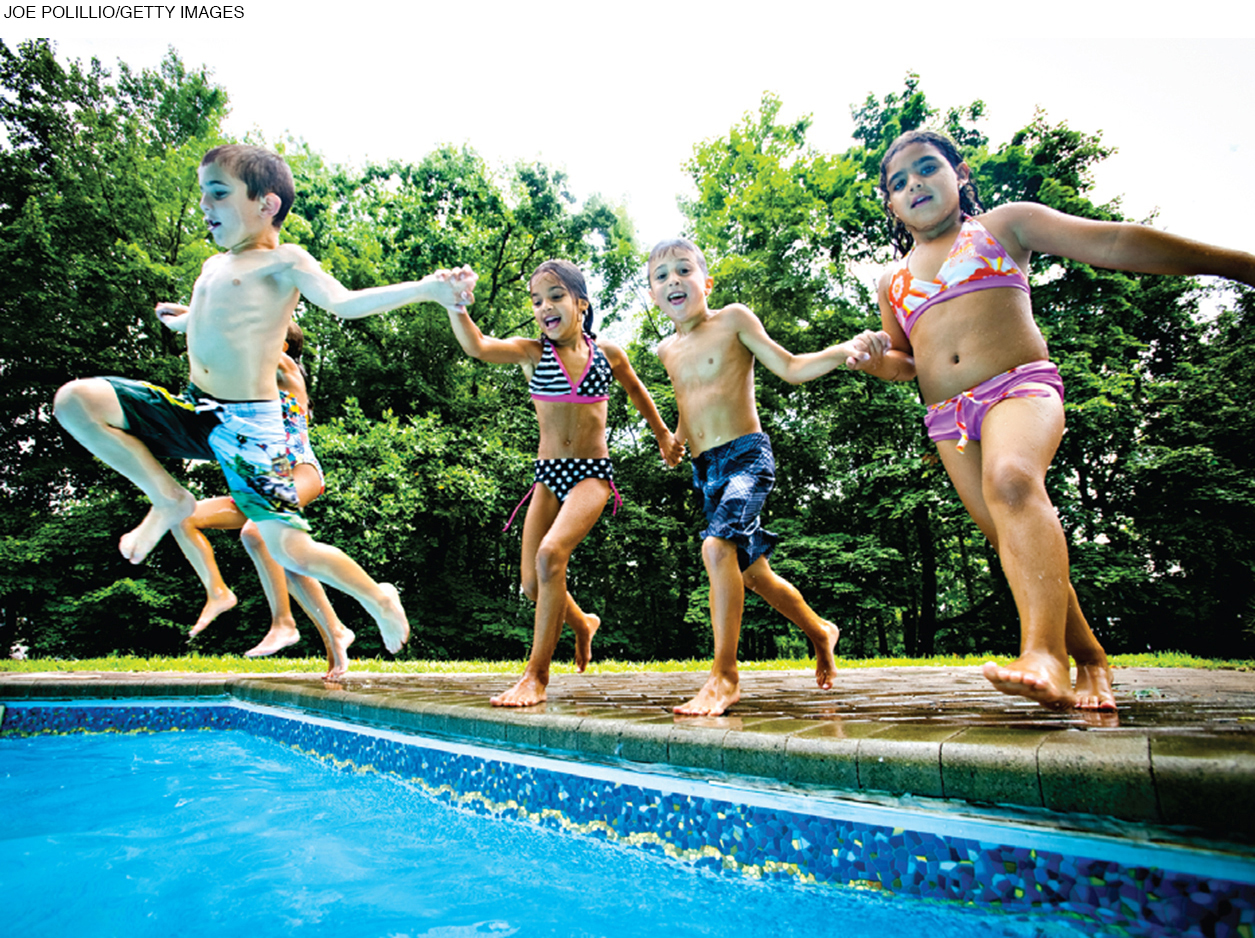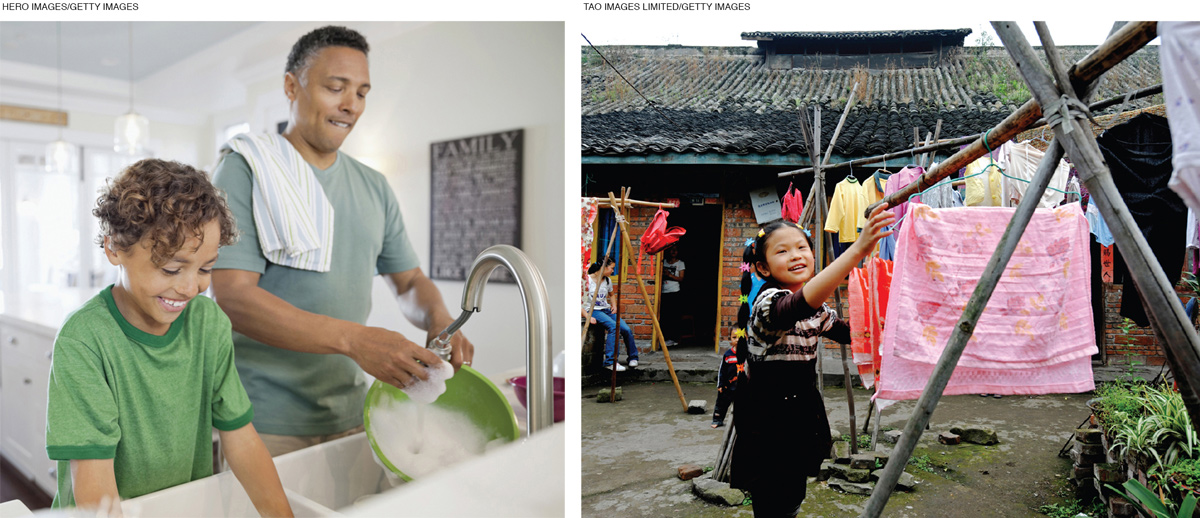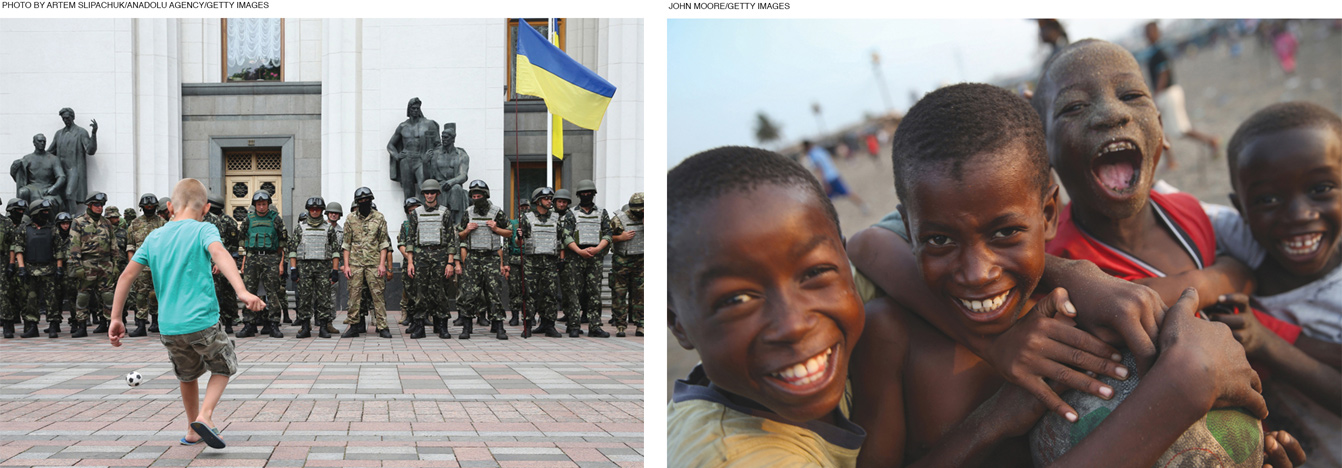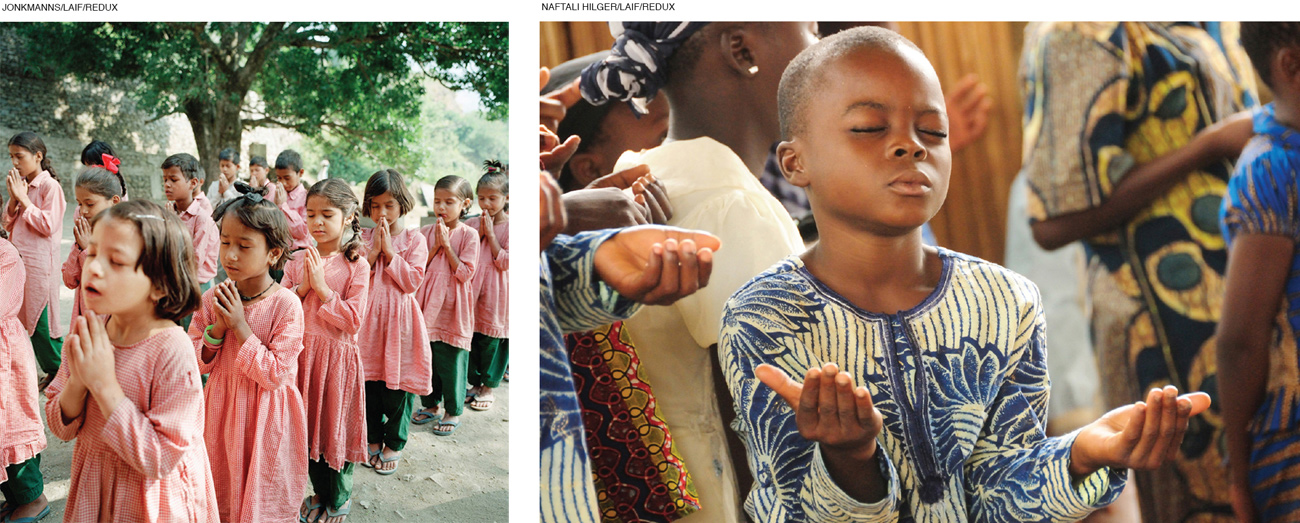The Nature of the Child

As explained in the previous chapter, steady growth, brain maturation, and intellectual advances make middle childhood a time for more independence (see At About This Time). One practical result is that between ages 6 and 11, children learn to care for themselves. They not only hold their own spoon but also make their own lunch, not only zip their own pants but also pack their own suitcases, not only walk to school but also organize after-
Over the same years, parent–
The drive for independence from parents expands the social world. School-
Self-Concept
Throughout the centuries and in every culture, school-
SOCIAL COMPARISON As children mature, they develop their self-concept, which is their idea about themselves, including their intelligence, personality, abilities, gender, and ethnic background. Self-
Now, in middle childhood, the self-
social comparison
The tendency to assess one’s abilities, achievements, social status, and other attributes by measuring them against those of other people, especially one’s peers.
Crucial during middle childhood is social comparison—comparing oneself to others (Davis-
All children become aware of gender discrimination, with girls complaining that they are not allowed to play some sports and boys complaining that teachers favor the girls (Brown et al., 2011). Some children—
Over the years of middle childhood, children who recognize prejudice and react by affirming pride in their gender and background are likely to develop healthy self-
Affirming pride is an important counterbalance, because, for all children, increasing self-
In addition, because children think concretely during middle childhood, materialism increases, and superficial attributes (hair texture, sock patterns) become important, making self-
industry versus inferiority
The fourth of Erikson’s eight psychosocial crises, during which children attempt to master many skills, developing a sense of themselves as either industrious or inferior, competent or incompetent.
ERIKSON’S INSIGHTS With regard to his fourth psychosocial crisis, industry versus inferiority, Erikson noted that the child “must forget past hopes and wishes, while his exuberant imagination is tamed and harnessed to the laws of impersonal things,” becoming “ready to apply himself to given skills and tasks” (Erikson, 1993, pp. 258, 259).
Think of learning to read and add, both painstaking and boring. (Slowly sounding out “Jane has a dog” or writing “3 + 4 = 7” for the hundredth time is not exciting.) Yet school-
This was apparent in the case in Chapter 7, comparing mothers from Taiwan and New England. When Tim’s mother helped him figure out how to do a particular kind of math problem that had him “clumsy” in class, she wrote out a page of problems for him, and then he did “the whole thing lickety split . . . [which made him] very happy” (Li et al., 2014, p. 1218). Similarly, children enjoy collecting, categorizing, and counting whatever they gather—
| Signs of Psychosocial Maturation Developing Between Ages 6 and 11* |
|---|
| Children responsibly perform specific chores. |
| Children make decisions about a weekly allowance. |
| Children can tell time, and they adhere to set times for various activities. |
| Children have homework, including some assignments over several days. |
| Children are less often punished than when they were younger. |
| Children try to conform to peers in clothes, language, and so on. |
| Children express preferences about their after- |
| Children are responsible for younger children, pets, and, in some places, work. |
| Children strive for independence from parents. |
| *Of course, culture is crucial. For example, giving a child an allowance is typical for middle- |
Overall, children judge themselves as either industrious or inferior—deciding whether they are competent or incompetent, productive or useless, winners or losers. Self-
Interestingly, the social judgments most valued come from peers of the same sex. Everywhere, children choose to be with other boys or girls. Indeed, boys who write “Girls stay out!” and girls who insist “Boys stink!” are typical. From a developmental perspective, this temporary antipathy (which Freud called latency) is a dynamic stage. Children shift away from sexual interests—
Culture and Self-Esteem
Apparent in many of the examples just mentioned, cultures and families differ in which attitudes and accomplishments they value, and children respond to that. Everywhere, however, academic and social competence benefit from the realistic self-

OPPOSING PERSPECTIVES
Protect or Puncture Self-
Unrealistically high self-
Of course, teachers and parents hope children will have adequate self-
Many cultures expect children to be humble, not prideful. For example, Australians say that “tall poppies are cut down,” the Chinese say “the nail that sticks up is hammered,” and the Japanese discourage social comparison aimed at making oneself feel superior. However, that perspective is not held by everyone, even in those cultures.
A trio of researchers, acknowledging that “Whether high or low self-
On the other hand, a study of fourth-
Self-
For example, some school report cards are graded from “Excellent” to “Needs improvement,” not from A to F. Some schools promote children to the next higher grade each year (called social promotion) whether or not they have learned the work, fearing that children’s self-
An opposite perspective is implicit in the No Child Left Behind Act, which closes schools that are rated as failing. Children are tested from the third grade on, and they are held back if they have not achieved third-
One component of self-
The hope is that children should develop an incremental idea of intellectual and personal traits, which means that they can develop themselves bit by bit, rather than an entity concept, which means that whatever they are (smart or dumb, handsome or ugly) is who they are by nature, for life (Dweck, 2013).
For example, children who fail a test may be devastated if failure means they are not smart. However, process-
Watch Video: Interview with Carol Dweck to learn about how children’s mindsets affect their intellectual development.
Self-
THINK CRITICALLY: When would a realistic, honest self-
Thus, as with most developmental advances, the potential for psychological growth is evident. However, advance is not automatic—
Resilience and Stress
In infancy and early childhood, children depend on their immediate families for food, learning, and life itself. Then “experiences in middle childhood can sustain, magnify, or reverse the advantages or disadvantages that children acquire in the preschool years” (Huston & Ripke, 2006, p. 2). Some children continue to benefit from supportive parents; others escape destructive family influences by finding their own niche in the larger world.
Surprisingly, some children seem unscathed by early experiences. They have been called “resilient” or even “invincible.” Current thinking about resilience, with insights from dynamic-
Differential susceptibility is apparent because of genes and also because of early child rearing, preschool education, and culture. As Chapter 1 explains, some children are hardy, more like dandelions than orchids, but all are influenced by their situation (Ellis & Boyce, 2008).
resilience
The capacity to adapt well to significant adversity and to overcome serious stress.
Two leading researchers have similar definitions of resilience: “a dynamic process encompassing positive adaptation within the context of significant adversity” (Luthar et al., 2000, p. 543) and “the capacity of a dynamic system to adapt successfully to disturbances that threaten system function, viability, or development” (Masten, 2014, p. 10). Both definitions emphasize that:
Resilience is dynamic, not a stable trait. A given person may be resilient at some periods but not at others. The effects from one period reverberate as time goes on.
Resilience is a positive adaptation. For example, if parental rejection leads a child to a closer relationship with another adult, that is positive adaptation.
Adversity must be significant, a threat to development or even to life itself.
| 1965 | All children have the same needs for healthy development. |
| 1970 | Some conditions or circumstances— |
| 1975 | All children are not the same. Some children are resilient, coping easily with stressors that cause harm in other children. |
| 1980 | Nothing inevitably causes harm. Both maternal employment and preschool education, once thought to be risks, may be helpful. |
| 1985 | Factors beyond the family, both in the child (low birthweight, prenatal alcohol exposure, aggressive temperament) and in the community (poverty, violence), are risky for children. |
| 1990 | Risk– |
| 1995 | No child is invincibly resilient. Risks are always harmful— |
| 2000 | Risk– |
| 2008 | Focus on strengths, not risks. Assets in the child (intelligence, personality), the family (secure attachment, warmth), the community (schools, after- |
| 2010 | Strengths vary by culture and national values. Both universal ideals and local variations must be recognized and respected. |
| 2012 | Genes as well as cultural practices can be either strengths or weaknesses; differential susceptibility means identical stressors can benefit one child and harm another. |
| 2015 | It is difficult to predict what makes one child resilient and another not, but early intervention— |

Question 8.1
OBSERVATION QUIZ
How can you tell that the Liberian boys are celebrating a soccer victory instead of the end of an epidemic?
They are hugging the ball.
CUMULATIVE STRESS One important discovery is that stress accumulates over time, with minor disturbances (called “daily hassles”) having an impact. A long string of hassles, day after day, is more devastating than an isolated major stress.
Almost every child can withstand one trauma, especially if parents do not add to the fear. Repeated stresses, heightened reactions, daily hassles, and multiple traumatic experiences make resilience difficult (Masten, 2014; Catani et al., 2010).
The social context—
These war-
An example from the United States comes from children temporarily living in a shelter for homeless families (Cutuli et al., 2013; Obradović, 2012). Compared to other children from the same kinds of families (typically high-
The probable reasons: Residential disruption, when added to other stresses, is too much. They suffered physiologically, as measured by cortisol levels, blood pressure, and weight, and psychologically, as measured by learning in school and the number of good friends. Again, protective factors buffered the impact: Having a parent with them who provided affection, hope, and stable routines enabled some children living in shelters to be resilient.
Similar results were found in a longitudinal study of children exposed to a sudden, wide-


Video Activity: Child Soldiers and Child Peacemakers examines the state of child soldiers in the world and then explores how adolescent cognition impacts the decisions of five teenage peace activists.
COGNITIVE COPING Obviously, these examples are extreme, but the general finding appears in other research as well. Disasters take a toll, but factors in the child (especially problem-
A pivotal factor is the child’s interpretation of events (Lagattuta, 2014). Cortisol increases in low-
Do you know adults who grew up in low-
In general, children’s interpretation of family circumstances (poverty, divorce, and so on) is crucial. Some consider their situation a temporary hardship; they look forward to leaving childhood behind. If they also have personal strengths, such as creativity and intelligence, they may shine in adulthood—
parentification
When a child acts more like a parent than a child. This may occur if the actual parents do not act as caregivers, making a child feel responsible for the family.
The opposite reaction is called parentification, when children feel responsible for the entire family. They become caretakers, including of their actual parents. Here again, interpretation is crucial. If children feel burdened and unable to escape, they are likely to suffer, but if they think they are helpful and their parents and community respect their contribution, they may be resilient. This might explain a curious finding: European American children are more likely to suffer from parentification than African American children are (Khafi et al., 2014).

THINK CRITICALLY: Is there any harm in having the oldest child take care of the younger ones? Why or why not?
In one more example, children who endured Hurricane Katrina in 2005 were affected by their thoughts, positive and negative, more than by other expected factors, including their caregivers’ distress (Kilmer & Gil-
WHAT HAVE YOU LEARNED?
Question 8.2
1. How do Erikson’s stages of cognition for preschool-
School-
Question 8.3
2. Why is social comparison particularly powerful during middle childhood?
In preadolescence, the peer group becomes especially powerful because children compare themselves to others in order to form a realistic self-
Question 8.4
3. Why do cultures differ in how they value pride or humility?
The answer to this question has to do with how the culture views the individual. For example, students in the Unites States are taught to value independence, cultivate pride, and be their own personal “best.” Children in collectivist cultures, like Japan, are taught to value the good of the group over the independence of the individual and to cultivate modesty.
Question 8.5
4. What factors help a child become resilient?
A child’s problem-
Question 8.6
5. Why and when might minor stresses be more harmful than major stresses?
When “daily hassles” accumulate, they can become more devastating than an isolated major stress. Almost every child can withstand a single, major event, but repeated stresses make resilience difficult.
Question 8.7
6. How might a child’s interpretation affect the ability to cope with repeated stress?
When a child doesn’t take things personally or doesn’t view negative situations as permanent, it is much more likely that the child will be resilient.
Question 8.8
7. What does the evidence say about how children respond to major disasters?
After major disasters, quickly returning to school routines is especially helpful because children benefit from routines and preparation for their future. Spiritual faith and religious rituals may help also children cope with disaster.